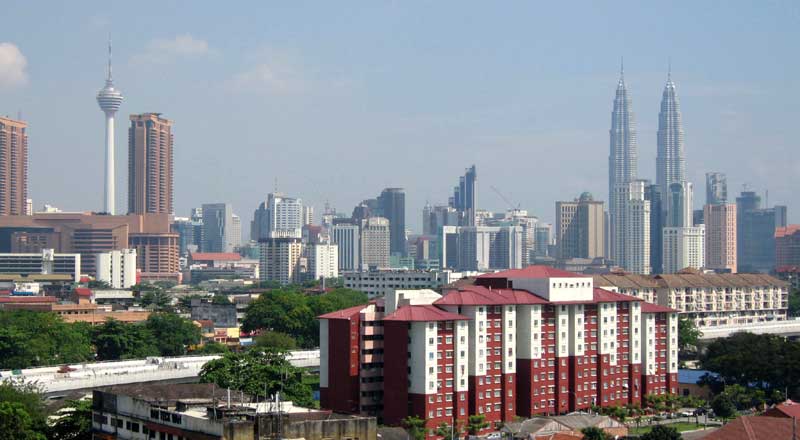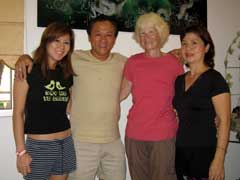April 24, 2007
Reflections in California
I feel good. After a long and arduous flight, we arrived in Los Angeles. We are staying at my Dain and Marleta’s apartment. I thought the jet lag was not immediately evident. We spent this past week with them. It is great to see your kid after six months, especially since Dain so rarely returns to the Midwest. We talked, and went out for dinner most every night. Betty cooked a couple of time. The coop-de-resistance was the Easter ham and sour cream potatoes. Yes, we knew that Easter had come and gone two weeks ago, but Dain and Marleta did not seem to care. Plus, I had not had a real ham in almost a year. It was great.
I called my cousin Steve and asked him to visit with us in Santa Monica. Meanwhile Betty’s brother John had made plans to come down to Santa Monica to see us. Both of them showed up on Thursday. I had a great day visiting with Steve. Betty made pad thai that evening and we all ate together. Steve returned to Victorville and John stay in Santa Monica until Sunday.
Reflecting on our trip through Asia:
We visited seven nations: China, Vietnam, Cambodia, Laos, Thailand, Malaysia and Singapore. They all had their pluses and minuses, but some were far more enjoyable than others. China and Thailand were my favorites and Cambodia and Laos were merely OK, while Vietnam, Malaysia and Singapore were good places to visit.
China was the most interesting. It has the friendliest people. The ease of travel is high with great air, train and bus transport. The accommodations were good, but not the cheapest. The food was tasty and not too expensive. And when we needed it, we could always find a McDonalds. The only draw back is language, but with a good phrasebook this problem can be overcome. It is a place that we certainly wish to return. It piqued our curiosity about the rest of northern Asia.
The place that we liked most in all of SE Asia was Chiang Mai. The city is just the right size. Accommodations are very inexpensive. It is easy and cheap to rent a motorbike. There are plenty of good restaurants that offer a wide range of prices and cuisines. The positives of Chiang Mai put Thailand on the top of our enjoyment list. Like China Thailand has great roads and good intercity bus transportation. The trains are very cheap, but not a nice as the ones in China. Another big plus for us was great broadband internet services not only in cyber shops but often in guesthouses and hotels.
Vietnam is a mixed bag. Only the cost of the visa was high, everything else was very reasonable. There are lots of great tourist services, mainly because there are so damn many tourists. The people are fairly private or introverted, and so they appear to be the least friendly of the countries we visited. Hanoi is a better city to visit than Ho Chi Minh City. Based on what we know now, the only things that we would have done differently here would be to spent more time in Nha Trang and in the Mekong delta.
In my mind, there is no difference between Singapore and Malaysia, except the higher prices in Singapore. So, when I speak of one, I am also speaking about the other. Malaysians are the friendliest people in SE Asia. It is also the most expensive place to visit. Due to lack of large numbers of tourist, the tourist services are weak. They have the most advance infra structure in SE Asia. Bus and train transport is good and easy to use. There is not as much to do and see in this part of SE Asia.
Cambodia is in expensive. The road and bus service between Phnom Penh Siem Reap are good. Hotel and guesthouses are inexpensive, clean and comfortable. Life is slow and comfortable. The temples at Angkor were wonderful. The rest of the country is very underdeveloped, meaning poor folks and a poor infrastructure. Laos was a lot like Cambodia.
We learn a lot every time we go someplace. We learn about the people and places. We learn about how to travel. As to people and places, the number one lesson we leaned on this trip was that everything we ever had been told about China was a big fat lie. As to travel the greatest thing that we learned about was couch surfing. I am sure that we will continue to be member of couch surfing community, because it opens doors to know a place and its people in a very real and intimate way.
Betty and I will be traveling in the next year. You can expect to find many new stories as we find new places to visit. Tomorrow we will be back in the Midwest. Before we return to the road, I will occasionally update this BLOG with a story and photos.
April 16, 2007
Singapore - Hot, Humid and Clean
To view a slideshow from
Singapore, press HERE.
On the Streets of Singapore  |
More of Singapore  |
At the Raffles Hotel  |
Chinatown Shop |
The bus on Saturday took about five hours to get to Singapore. We walked about ten minutes to a nearby MRT station. Two stops later we were walking again to our hotel, the Fragrance, Ruby. The neighborhood is quite lively, a mixture of working class and working girls. Singapore is very expensive. A lot of things cost more than in the states and certainly more than any other country that we have visited in Asia. This super budget hotel costs $42 per night, the most we paid anywhere in Asia. A 24-ounce bottle of beer costs at least $3 USD. Compare that to China where is cost less than 50 American cents. These two examples should suffice.
We explored the city on Sunday. It is by far the most beautiful city in SE Asia. It is super clean, modern, great (but expensive) public transportation, hundreds of western franchised stores. The only thing wrong with the place is the heat and the humidity. Like Malaysia it is over 90 (32c) and dew points in the mid 70’s, which for folks that know nothing about dew points is so damn uncomfortable that you want to die. Only AC makes the city bearable. We walked down Orchard Park Road, the Fifth Avenue of Singapore. We saw the famous Raffles Hotel. It deserves its great reputation. The old building had a fantastic redevelopment around 1990. We walked into the Anglican Cathedral and visited the old parliament building. The river, the old bridges and the colonial buildings all mixed in with modern skyscrapers are quiet the sight - even if the modern are far inferior architecturally to Kuala Lumpur. We skipped Chinatown and the Indian Quarter, but could have seen it all in one day. What that means is that the city is knowable in just one day. If you come this way, two nights should do nicely and three at the very most.
Chinatown is very small and basically a tourist-draw to expensive, low-grade souvenirs. We tried to stretch out our visit by eating and still we had seen enough in less than two hours. At one time the Indian district was adjacent to Chinatown, which explains why there is a beautiful old Hindu temple there. We took a bus to the Indian area. Like Chinatown, it is very small. To be honest, there was not much to see.
We returned to our hotel by mid-afternoon to prepare for our flight back to the United States.
April 14, 2007
Melaka, a City of Old
To view a Melakan slideshow, press HERE.
Around St. Paul's Church  |
Scenes around Melaka  |
Melaka River  |
Song and Dance in Melaka |
On Sunday Betty and I traveled by bus to Melaka. The bus station is a few kilometers north of the city center. We got a ride to a so-called hotel that was more like a guesthouse by the owner from the train station. His price was far too high for the quality he offered. I began to search the city. I had a list that I worked off. We had heard about the Fenix Inn from another traveler, which is where we ended up after checking out many places. All of them were expensive compared to the rest of SE Asia. The Fenix was not the cheapest, but it was the best value at $25 per night.
The next day we checked out. We left our baggage at the hotel, and we would return around 6:00 PM to either check back in or pick it up.
We spent the day exploring the older part of the city. One can see the primary historical sights in one day. Melaka, spelled Malacca until just a year ago, was more than a city 600 years ago. Then a Sultan created a state that encompassed much of western Malaysia and eastern Sumatra. 100 years later the Portuguese invaded and took over. The Portuguese were followed by the Dutch and then the English, who allowed Malaysia to become independent in 1957. Melaka was the center of all these rulers. There is an old fort, ancient churches, and administrative buildings, built by the Portuguese, Dutch and English. We also walked through Chinatown. 90% of the city residents are ethnically Chinese and 20% of the city is Christian, which is unusual in a country that is 75% Moslem and close to 25% Buddhist.
We planned to connect with a couch surfing host in the evening. When we returned to our hotel, we waited to see if she would come to fetch us before checking back in. Finally, Allegra arrived and we went to her apartment. She is a marketing consultant on a temporary job contract in Melaka. The company provides her with a sparsely furnished three-bedroom apartment, which she was kind enough to share with us. As with our previous surfing experiences, we talked on and on getting to know each other. Along the way, we went to small Malay restaurant run by Suzanne. Before we knew it was well after 11:00 PM and I was yawning. We got a room to ourselves with mattresses on the floor. We both slept great.
Betty, Allegra and Bill
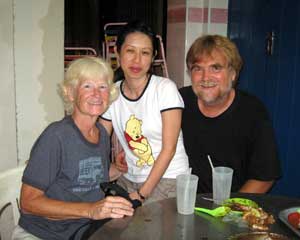
On Tuesday we did not do a lot of things. We again walked to the historic district. We had lunch in Chinatown. Then we visited the Baba Nyonya Heritage Museum, which is an old house. Baba Nyona refers to the children of early Chinese immigrants who married the local Malay women. The boys were babas and the girls were nyonyas. This house was really three houses for three generations: children, parents and grand-parents. The family that owns this house is well into the sixth generation. The houses were really great with hand carved stairways, old furniture, lanterns, costumes, etc. We stopped twice at an air conditioned mall, where there was a stage and cultural performances all day long. In the evening we spent a lot of time talking with Allegra.
Things slowed down on Wednesday, Thursday and Friday. We hiked to an old Portuguese settlement area on Wednesday. It was hard to believe that there are still many Portuguese living here after 400 years. It was easy to see that the children in the neighborhood had Portuguese blood flowing in their veins. We are sure that there has been some intermarriages, but - still - after 400 years, one might think that it would disappear. Thursday was even slower, all we did was go to a movie. It was a bad one at that. I guess that I just do not care for those supernatural horror flicks. And The Reaping certainly was one of those that I dislike. Friday we waited until Allegra got home in the early afternoon. She had to go back to Penang to tend to her sick mom. We had lunch before she left. After that we waited for the Chinatown to get busy as it does on every weekend. It is a colorful fun time.
We love staying with Allegra. She was a great hostess. Allegra is a kind and generous person. Although she worked all day, we were able to eat dinner with her every night. She introduced us to some great Nyona food from local curries to fabulous deserts, made with cream, palm sugar, nuts, fruits and ice. My favorite was the hot pot of boiling satay peanut sauce in which we cooked sticks filled with meat, prawns, veggies, fried bread, and more. It was simply scrumptious!
Today we are off to Singapore. It will be our last stop before returning to Los Angeles.
View of Malacca Straights from St. Paul's Church

April 12, 2007
Two Books Worth Reading
One of the things that I always do when traveling is read books. I have read many on this year’s journey. In my BLOG entries I usually write about the places and things that I have experienced. This time I am going to write about a couple of books I recently read.
Being world travelers, Betty and I tend to view things a bit differently from those who travel little. While in Argentina, we got hammered by Matt and Betty’s brother - John - about Peak oil. This got us thinking about all of the implications. It is clear to me that within 20 years a gallon of gas will cost $20 or more in today’s money. It will certainly be a changed world. And not just for the USA, because in all the developing countries people want to have cars just like we do in the USA. I cannot blame them, because it makes life so much easier. Their demand in an era of dwindling supplies is another factor that will push up prices. The reality is that we already are dealing with the results of the coming shortages, as seen by the failed oil grab in Iraq. And long after the oil is gone we will be dealing with the effects of burning all that fossil fuel, when global warming transforms the costal areas where everybody lives. Having these ideas floating through my thoughts made a couple of books really jump out at me. I highly recommend that you read them; they will rock your world.
Here are my thoughts on them and the thoughts of some of the critics, which I copied from the Barnes and Noble web site.
|
American Theocracy  I read American Theocracy and found it riveting. Kevin Phillips is an old line Republican. Anyone who knows me, knows that I do not take much stock in what folks of the GOP have to say. Here was the exception. Kevin brilliantly researches the effect of the born-again Christians taking over GOP and the federal government. What is more surprising is that he does it in an historical context, relating the religious shift in the USA to other great nations at their pinnacle and the precipice of their fall from heights of imperial power into a much less glamorous role on the world scene. Phillips weaves this religious take over with events in the Middle East and especially Iraq. He also talks about the how these forces united with finance capital to create the mess we find the USA in today. I found Phillips analysis fascinating and one the best researched books of its type. Please, pick it up, look it over and read some of it and see if you do not agree with me. Reviews of American Theocracy found at Barnes and Noble. Publishers Weekly Library Journal Kirkus Reviews |
Collapse: How Societies Choose to Fail or Succeed 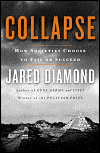 Diamond’s book is more academic, but not less critical that Phillips’ book. Diamond explores several criteria that he believes lay the basis for the collapse of a society. His work is based on the collapse of several civilizations including Norse Greenland settlement, the Maya, the Easter Islanders and the transformation of modern Montana. Along the way he compares these old societies to the modern age. As I read his tome, time and again I thought about how the modern world will find it very difficult to change as oil is depleted from the earth.
Synopsis Reviews of Collapse found at Barnes and Noble.
Robert D. Kaplan - The Washington Post
Michiko Kakutani - The New York Times
Publishers Weekly
Foreign Affairs |
April 08, 2007
Kuala Lumpur, a Modern Metropolis
To view a slideshow from
Kuala Lumpur, press HERE.
The Flag of Malaysia  |
Betty, Seri and Salsa 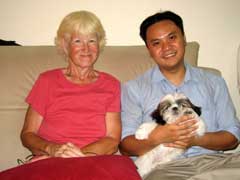 |
Petronas Towers 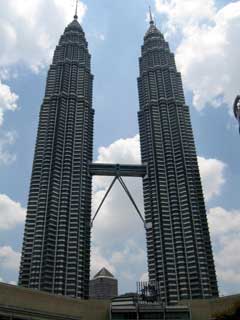 |
In Central Kuala Lumpur  |
KL’s Lake Garden Park 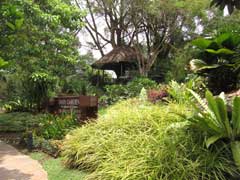 |
A New Travel Alternative:
Couch Surfing
Betty and I learned about couch surfing from our good friends, Paivi and Santeri. Couch surfing is a new travel alternative. I like to use the analogy of file sharing to explain couch surfing. In file sharing a person shares his music or video files with friends and through some peer-to-peer web sites with the world. In couch surfing a person shares his couch with a friend or a stranger. You connect with strangers at CouchSurfing.com where Betty and I registered two months ago. We did not feel the need to couch surf until we got to Malaysia, where accommodation costs are two to three times greater than the rest of Southeast Asia. Couch surfing can be done all over the world, not just in Asia. I checked the number of folks offering a couch in the Minneapolis area, and I found more than 150 couches.
How can you couch surf?
First you register, which costs nothing. Then you search for a couch in a city you plan to visit using the provided search tool. You look through the list of folks with couches. Click on their names and their profiles appear. Then you send an email to a few of the people that seem like a good fit. You will want to send several email messages, because we sent out about nine for KL and got three responses. Finally, you meet your potential host and hopefully enjoy a few days with them.
CouchSurfing.com is not the only hospitality service organization. There are several others. One of the organizations is Hospitality Club. I met the president of the local chapter of Hospitality Club, while in KL. Another organization is Global Freeloaders. Personally, I could never belong to an organization called free loaders, but I am sure some find the name charming. Wikipedia lists several other hospitality organizations, like WOOFF and Servas International. In these later organizations, you often work or help others where you are staying. Take a look at their web sites.
In my previous entry I mentioned how friendly all the Malaysians have been. They continue to be warm, kind and gracious to us. Two of these gracious Malaysian, Benny and Esther, agreed to give us a lift to KL from Cherating. How all of our gear and their gear and their two pet rabbits fit into their little car was beyond my understanding. The roads and highways of Malaysia are simply excellent. The four-lane expressway and toll road wound its way through rolling hills, thick jungles and vast palm plantations. The country is the greenest we have seen; probably, because it is the rainy season now. Green is beautiful to me, so Malaysia is beautiful. After three hours of enjoying the countryside, we arrived in Kuala Lumpur.
We did not check into a hotel in KL. We went to the flat of Seri Naga Leong. He was going to be our host for the next four nights. To put it mildly, Seri is a great guy. We met Seri online through the couch surfing website. To learn more about couch surfing, read my comments on the left. We had many long and interesting conversations with Seri. He had much to ask about America and he had much to tell us about Malaysia. In the middle of our conversation, we all went for a walk to have a dinner at wonderful outdoor restaurant a couple of blocks away to eat chicken satay and fat rice. Not long after we returned to the apartment, his partner, Felicia, came home. She is a lovely young woman. Seri and Felicia are professionals. He sells botox to doctors; and she is a loan officer with a local bank. Besides these two, there were three others living in the apartment: Michael, another roommate, and two little Shih Tzu dogs called Nachos and Salsa. We continued to talk late into the evening. The couch would have been ok for me, but not with Betty. So we slept on a comfortable mattress that lay on the living room floor.
The next three days, we really got to see Kuala Lumpur. We started at the Petronas Towers, made famous in several movies. They are simply stunning to see. They are more beautiful than any picture can show. These towers are not the only great architecture in this city. The modern buildings are just fantastic. We were continually surprised as we discover one after another as we walked and rode around KL. But modern architecture is not the sum total of KL architectural excellence. The Moorish influenced high court building is delightful to view. We saw many of these 19th century masterpiece buildings.
KL is a very green city. Trees can be seen in most neighborhoods and even in the city center near the Petronas Towers. There is a large and extremely beautiful park, called the Lake Gardens. In it we found an orchid garden, hibiscus garden, a bird park, a deer park, sculpture garden, and a running path with exercise apparatus along the way. The gardens are extremely well maintained.
The weather is hot here, especially when the sun is out. Everyday it was in the 90’s and extremely humid. Our first three days it started raining at 4:00 PM and stopped around 6:00 PM.
Riding the Bus in KL

Every evening we talked and talked with Seri. He also gave us copies of some Heroes episodes that we had missed; and we gave him couple of audio books. On Wednesday he had to leave for Ipoh, but we were allowed to remain another night. I have got to add that I really love this couch surfing, because we got to really know our host. It is so much more personal than the impersonal experiences of life in a hotel.
On Thursday we moved to the Wongs’ home. They live on the outer edge of KL in the Overseas Union Garden, named after the Bank that developed the area. We wanted to live with a family for a few days. And the Wongs seemed perfect. They were perfect. The Wongs are Simon, Karen, Phoenix and Jeaney - father, mother and two daughters. They live in a beautiful home in a very nice neighborhood with two dogs.
On Friday, the family was busy with work and school. In the evening we went to restaurant and met a couple of fellows, C.K. Tan and Selva, in the local Hospitality Club (see sidebar on couch surfing.) On Saturday, I got up at sunrise and went with Simon to hike in the nearby hills of Bukit Gasing. We met several on his friends, Mr. Young, Mr. and Mrs. Leong and another fellow. The hike was extremely strenuous for me and we climbed and descended along a rough path through a thick jungle. There were hundreds of people who shared the path with us. Everyone was out for their morning exercise. After 75 minutes I was totally done in, while the locals seemed completely at ease. We had a typical Chinese breakfast of noodles and meat before returning to Simon’s home. In the afternoon, Simon, Betty and I met C.K. We drove to the new city of Putrajaya. It is about 35 kilometers south of KL. It is a city of federal government ministries and their buildings, the residence and offices of the Prime Minister, a new residence for the local Sultan, a new, colossal mosque, a huge man-made lake many bridges across the lake. We went to see the architecture. I will state it again and again, Malaysia has some of the best architecturally designed building in the world. In the evening we had a great meal prepared by Karen.
We left Kuala Lumpur this morning. Our stay with the Wong family was great.
We will miss all our new friends. Seri Naga and Felecia were wonderful hosts, too.
The other thing about today, the 8th of April, is that it is Betty’s birthday.
Happy Birthday, Honey!
View from Seri Naga’s Apartment
